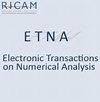大型Lyapunov和Sylvester方程的自生成和有效移位参数的ADI方法
IF 0.8
4区 数学
Q3 MATHEMATICS, APPLIED
引用次数: 73
摘要
交替方向隐式迭代(ADI)的低秩迭代是求解大规模Sylvester和Lyapunov方程数值解的常用方法。这些方法最大的缺点可能是它们依赖于一组对快速收敛至关重要的移位参数。在这里,我们首先回顾了现有的位移生成策略,这些策略在实际迭代之前计算了许多位移。这些方法有几个缺点,例如,昂贵的数值计算和难以获得必要的光谱信息或数据,需要初始设置它们的生成。其次,我们提出了两种新颖的转移选择策略,至少部分地解决了这些问题。这两种方法都在ADI迭代过程中自动产生移位。大量的数值测试表明,其中一种基于Galerkin投影到当前ADI数据所跨越的空间的新方法,在大多数情况下,在收敛速度和所需的执行时间方面都优于其他方法。本文章由计算机程序翻译,如有差异,请以英文原文为准。
Self-Generating and Efficient Shift Parameters in ADI Methods for Large Lyapunov and Sylvester Equations
Low-rank versions of the alternating direction implicit (ADI) iteration are popular and well estab- lished methods for the numerical solution of large-scale Sylvester and Lyapunov equations. Probably the biggest disadvantage of these methods is their dependence on a set of shift parameters that are crucial for fast convergence. Here we firstly review existing shift generation strategies that compute a number of shifts before the actual itera- tion. These approaches come with several disadvantages such as, e.g., expensive numerical computations and the difficulty to obtain necessary spectral information or data n eeded to initially setup their generation. Secondly, we propose two novel shift selection strategies with the motivation to resolve these issues at least partially. Both ap- proaches generate shifts automatically in the course of the ADI iterations. Extensive numerical tests show that one of these new approaches, based on a Galerkin projection onto the space spanned by the current ADI data, is superior to other approaches in the majority of cases both in terms of convergence speed and required execution time.
求助全文
通过发布文献求助,成功后即可免费获取论文全文。
去求助
来源期刊
CiteScore
2.10
自引率
7.70%
发文量
36
审稿时长
6 months
期刊介绍:
Electronic Transactions on Numerical Analysis (ETNA) is an electronic journal for the publication of significant new developments in numerical analysis and scientific computing. Papers of the highest quality that deal with the analysis of algorithms for the solution of continuous models and numerical linear algebra are appropriate for ETNA, as are papers of similar quality that discuss implementation and performance of such algorithms. New algorithms for current or new computer architectures are appropriate provided that they are numerically sound. However, the focus of the publication should be on the algorithm rather than on the architecture. The journal is published by the Kent State University Library in conjunction with the Institute of Computational Mathematics at Kent State University, and in cooperation with the Johann Radon Institute for Computational and Applied Mathematics of the Austrian Academy of Sciences (RICAM).

 求助内容:
求助内容: 应助结果提醒方式:
应助结果提醒方式:


